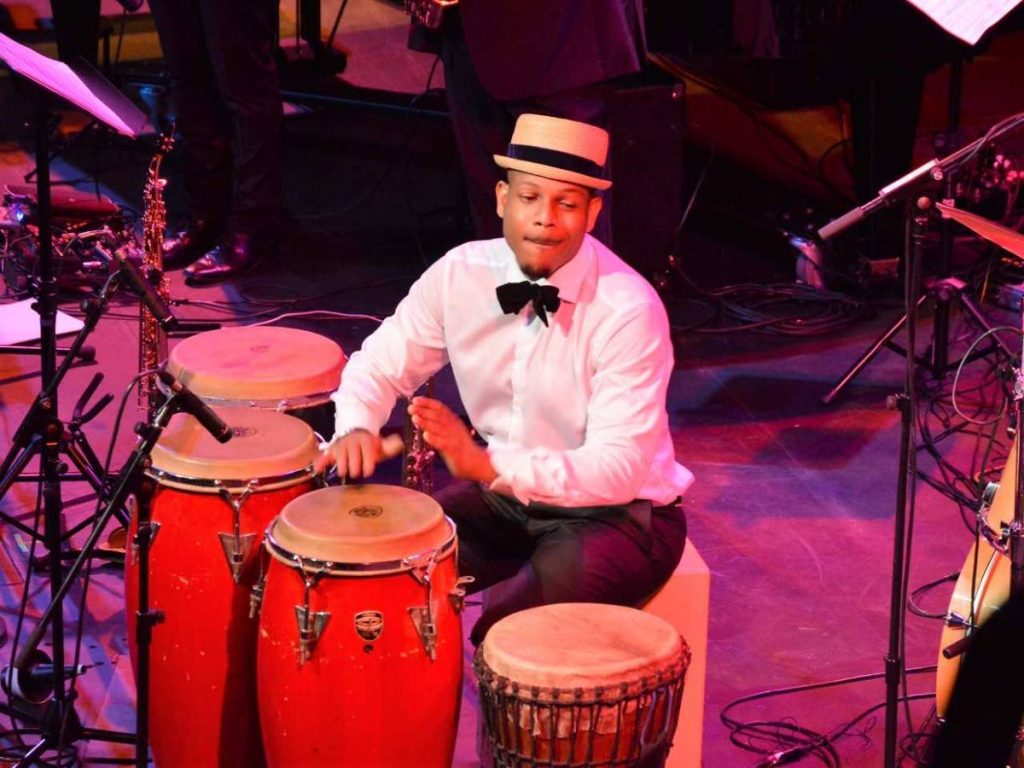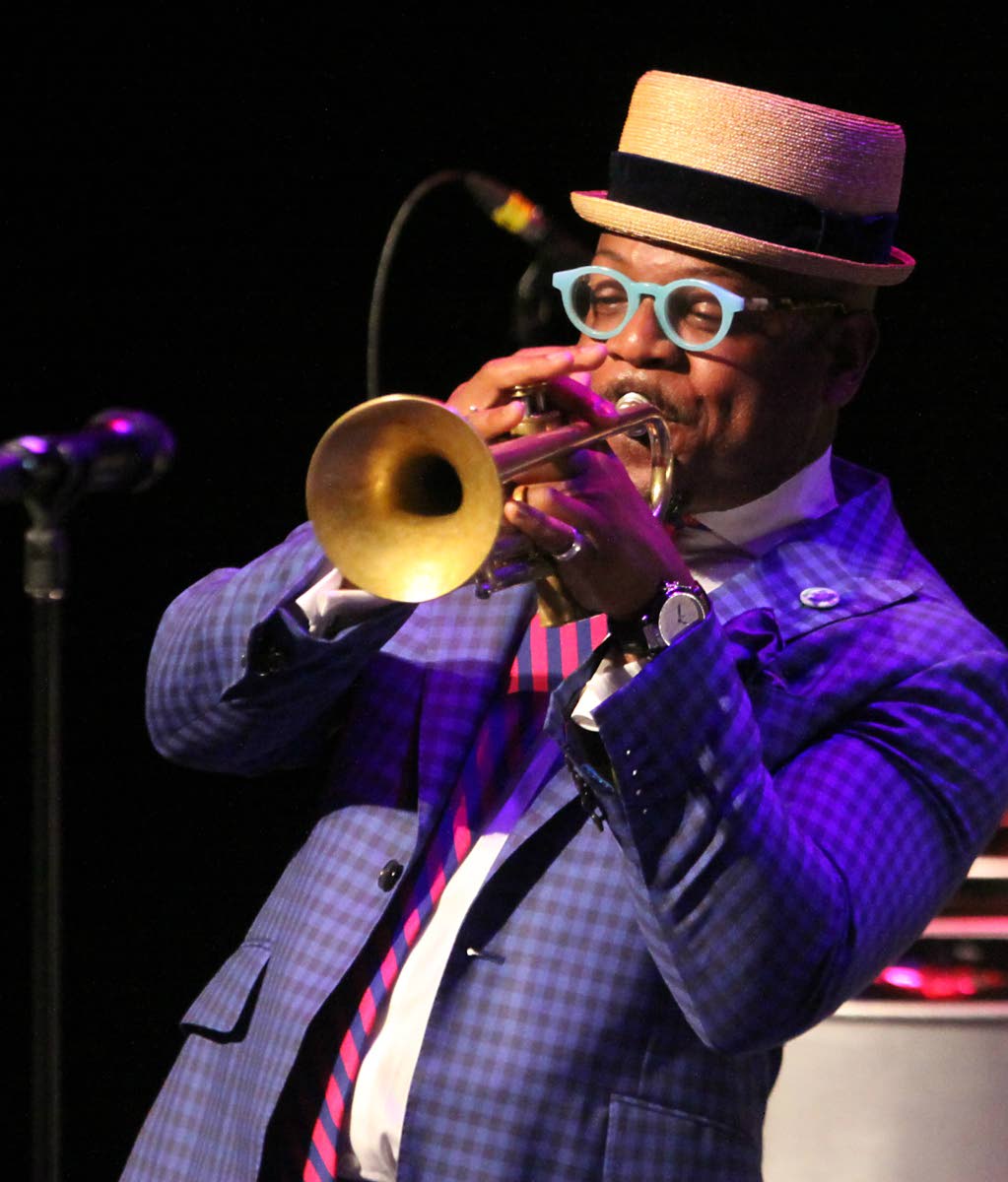Charles, Homecoming King

JOSH SURTEES
Jazz trumpeter Etienne Charles left Trinidad 15 years ago to pursue his career. Back in town to perform his Folklore album at Queen’s Hall, he talks to Newsday about gentrification, incarceration and the American Dream.
“I call myself a Glenconian,” Etienne Charles says down the phone. He’s heading for the airport in Detroit, on his way home to the familiar surroundings of suburban north-west Trinidad. Charles performs his jazz odyssey, Folklore, at Queen’s Hall on Sunday at 6 pm. In the run-up, rehearsals take place at home in Glencoe, where his parents, both retired public servants, have lived for 27 years.
“I try to make sure I get a good bit of Trinidad in my bones throughout the year,” he says. “Especially in the winter.”
In East Lansing, where he’s lived since taking a teaching job at Michigan State University in 2009, the weather is turning cold. Chilly winds sweep across from the Great Lakes. Fifty miles north-east is Flint, where the water is toxic. Ninety miles south-east is Detroit, whose troubles are well-documented. “I used to teach in Detroit every Wednesday,” he says. “Now I mostly go for gigs. It has a great history. Because of the great migration from the South, it ended up with a rich culture of music, not just Motown but jazz as well.”
He lists some of the greats who spent time there: saxophonist Joe Henderson, Count Basie-collaborator Frank Foster, double bassist Paul Chambers and Miles Davis, who kicked his heroin addiction in the Motor City in the 1950s. He also mentions the painters Diego Rivera and Frida Kahlo, who lived there in 1932 while Rivera painted a huge series of outdoor murals at the Institute of Art.
“The flight from the city centre happened in 2008 with the housing crash, but now there’s a new flight inwards,” Charles says of the city’s recent revival. “Gentrification, basically. Similar to Harlem and Brooklyn. Very cheap property got bought up and now there are fancy hipster restaurants and coffeeshops. I’m seeing exactly what I saw in Williamsburg, living in New York ten years ago.”
New York, where he studied post-grad at Juilliard, was the kind of dream every young black jazz musician coming to the States has. But before the Big Apple, Charles’ American adventure began in the sleepy, sultry south at Florida State University, Tallahassee. There, in 2002, he learned his art.
“I barely knew anything about jazz,” he says. “It was a crash course, learning with hotshots from all over the South. I would go to the practice room instead of going to sleep, I fell asleep listening to music. So that when I woke up the next morning I knew I was better than the day before.”
The director of jazz took a liking to what he was doing and gave him gigs – “the real way to learn, on the bandstand in front of people, falling on your face.”
A whole new world opened up, culminating in the recording of his first jazz album Culture Shock in 2006 and Folklore in 2008. Early next year, his third album Carnival: The Sound of a People comes out in two parts. Volume One will be available to purchase at Queen’s Hall.
There’s something full circle about this homecoming concert. The grand hall, built in 1959 on the edge of the Queens Park Savannah, was where Charles learned to play pan at a music camp in his youth. Now, aged 34, he will play to an audience most of whom have watched him grow.
He got his first trumpet after passing common entrance at ten and started attending band rehearsals with Major Eddie Wade on Oxford Street, Port of Spain before moving on to the Brass Institute school on Henry Street started by his good friend, saxophonist Tony Woodroffe in 1995.
All the time he was, he says, “playing by ear.”
“Of course, I teach composition now, but back then [sheet music] looked like maths. I would listen to the person next to me, watch what they were doing with their mouth and try to copy the sound.”
By the age of 18 he was playing in bands while still finishing his A-Levels at school. A typical Friday night would see him and Woodroffe playing three concerts in one evening, starting off at the Country Club, then on to the Squeeze bar on Ariapita Avenue to play with Venezuela-born Ernesto Garcia, then down to Screamers in San Fernando with the rock’n’roll band Orange Sky, often on the same bill as a band called Denizen, whose lead singer was a young pre-soca Kees Dieffenthaller.
“This was all pre-YouTube, before people posting videos of John Coltrane on Facebook,” he explains. If you wanted to steep yourself in jazz tradition in Trinidad back then, it was hard work. Florida made up for all that, teaching him what he calls: “a new language.”
As well as the prestigious Queen’s Hall, Charles and his band will play a very different venue on his trip home: Carrera Island Prison.
“We did one recently at Youth Training Centre, Golden Grove. Prisoners from maximum security, Carrera and Women’s Prison were also in attendance, and we got invited to play at Carrera. It will be a concert and workshop.”
Reminiscent of country singer Johnny Cash’s legendary concerts recorded at Folsom and San Quentin, Charles concerts could be beneficial to rehabilitation.
“It’s all about taking the music to those who wouldn’t be able to come get it,” he says. “There are quite a few musicians in the different prisons. There was a calypso competition going on [at Golden Grove], each kaisonian was backed by a full band.”
Does he see his music as political?
“I did a whole album [in 2015] called San Jose Suite about the effects of colonialism in the Americas on the indigenous people and people of African descent in three former Spanish colonies, California, Costa Rica and Trinidad.”
One element of that project alludes, instrumentally, to the protest movement of young black American athletes in the 60s that culminated in those famous Black Power salutes at the 1968 Mexico City Olympic Games.
“Still to this day athletes are having to protest. Things kind of haven’t really changed, the whole mass incarceration thing you know. Kitchener sang about police brutality in the fifties with If You’re Brown and I learned from calypsonians. Folklore was a statement about how the content and delivery of stories taught us how to communicate as a people.”
It’s a story well worth listening to and it’s told by the man himself on October 22 at 6pm.



Comments
"Charles, Homecoming King"